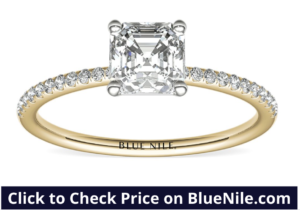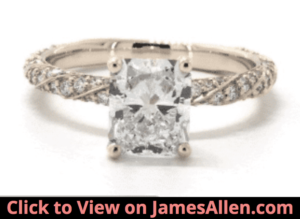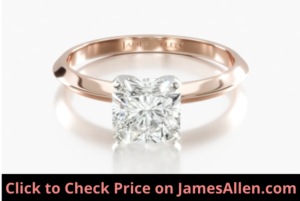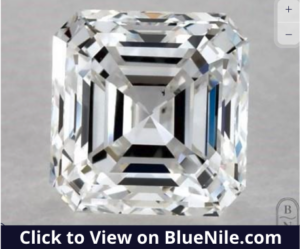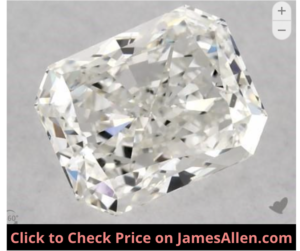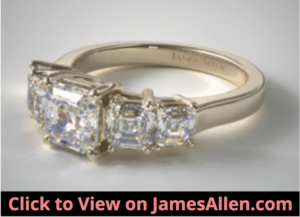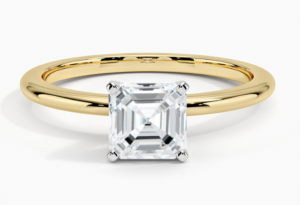
Asscher and radiant cuts are used in engagement rings and as accents in other pieces of jewelry.
The main difference between Asscher and radiant cuts is Asscher cuts are step-cut diamonds that often appear square, with four sides of equal length and cropped corners. Radiants are a brilliant cut with a rectangular shape and stronger brilliance.
Let’s compare Asscher versus radiant cuts across the most important aspects of a diamond, including their brilliance, clarity, durability, and more.
What is an Asscher Cut Diamond?
Asscher cut diamonds have a square shape with eight sides.
It’s a step-cut diamond, which means its 58 facets are layered in a way that results in a high crown and deep pavilion. This design emphasizes its clarity in favor of brilliance.
Check out the Asscher cut diamond ring below.
Its straight-edged facets have the same length and width. It’s four corners are beveled, creating an additional four sides that mimic the shape of an emerald cut.
The difference is its square shape compared to the elongated design of emeralds.
The Asscher cut was developed by the Asscher brothers in the early 1900s. They also created the Royal Asscher cut, which has 74 facets.
What is a Radiant Cut Diamond?
Radiant cut diamonds have a brilliant cut and a square or rectangular shape.
They have 70 facets designed to maximize white light return. In this way, it mimics facets in round-cut diamonds, which are triangular or kite-shaped.
The facets are cut in multiple sizes and angles, so the center often appears like crushed ice.
For example, here’s an image of a radiant cut diamond ring that has this effect.
A distinguishing feature is its cropped corners. They’re beveled in a way that removes sharp points and instead creates diagonal edges on each end.
Radiant cuts were the first diamond with a square shape and brilliant facet pattern on both the pavilion and crown.
Henry Grossbard created it in the 1970s by combining the methods used to design emerald and brilliant cuts. The result was a diamond that has a similar overall shape as emerald cuts but facets similar to a round cut.
How are Asscher and Radiant Cuts Different?
Shape
It’s easy to confuse cut and shape.
A diamond’s cut refers to its facet pattern and quality and how it interacts with light. Shape refers to its outline and differences in lengths, widths, and edges.
A benefit of radiant cuts is they come in multiple shapes.
Some are square, and others are rectangular. The optimal length-to-width ratio for square radiants is between 1.00-1.03.
A ratio of 1.03 isn’t technically a square, but the naked eye won’t notice the difference in its lengths and widths. It needs to be at least 1.05 to avoid appearing like a square.
I’ve added three images of radiant cuts with different ratios below.

To the naked eye, it’s difficult to tell them apart, but they’re clearly rectangles.
For a rectangular radiant, 1.20-1.30 is best. The diamond will have a rectangular shape but won’t be too elongated.
Asscher cuts can have a length to width ratio of 1.00 to greater than 1.08. The latter won’t look like a square, but the GIA defines any ratio of 1.00-1.05 as square.
In the case of Asscher cuts, that’s the ratio needed for an excellent cut.
Brilliance and Fire
Brilliance refers to how well a diamond collects and returns white light to the viewer. Fire is a similar effect but involves white light dispersing into a rainbow of colors.
Asscher cuts don’t have strong brilliance. In fact, the brilliance of an Asscher cut falls below many cuts, including oval, radiant, princess, and round.
But that doesn’t mean the diamond always appears dull. Check out the Asscher cut engagement ring in a halo setting below, and notice how it still shines in that high-resolution image.
Brilliant cuts have the best light performance, so the step-cut facets of Asscher diamonds aren’t designed to exhibit this trait.
The same is true for fire. Brilliants have more fire than step-cuts, so if you’re searching for a diamond that will display a rainbow effect, opt for a radiant versus Asscher cut.
To illustrate, here’s a radiant cut diamond with an excellent cut grade.
When you rotate the image, its brilliance is apparent as its facets appear to turn on and off.
Price
Asscher cuts are generally less expensive than radiant cuts. There is lower demand for Asscher cuts compared to radiant, which influences the price.
For example, the average price of a one-carat Asscher cut with an H color grade and SI1 clarity from James Allen is $3,013.
For a radiant cut of the same quality, the average price is $3,402. That’s a 13 percent increase in price for a radiant cut.
At Blue Nile, this one-carat Asscher cut, with an F color and VS2 clarity, costs $3,680.
This radiant cut, with the same grades from the GIA, is listed for $4,170.
You’ll find both cuts come in a range of prices.
There are instances when an Asscher cut costs more than a radiant, but in general, you can save money by opting for an Asscher instead of a radiant cut.
I recommend putting that savings toward a setting with pavé or channel set diamonds because they’ll compensate for an Asscher cut’s lack of brilliance.
Clarity
Radiant diamonds often look cleaner than Asscher cuts even if they have the same clarity grade.
A diamond’s clarity is based on how many inclusions are present and they’re affect on its durability, brilliance, and appearance.
Diamonds with no visible inclusions at 10x magnification earn a flawless grade, while those on the lower end of the spectrum have an I3 clarity.

A diamond’s brilliance can hide inclusions to the naked eye, causing it to appear to have a higher clarity.
For most radiant and Asscher cuts under two carats, VS2 clarity diamonds won’t have visible inclusions, but you should start your search at SI1.
For example, here’s a radiant cut that earned a VS2 clarity grade.
Even in high-resolution, inclusions aren’t visible.
Diamonds with those grades may still have feathers, twinning wisps, or etch channels, but they’ll be small and often transparent.
As you move into higher carat weights, inclusions are more likely to be visible.
Color
Diamonds are graded on a color scale from colorless to light based on how much yellow or brown is visible.
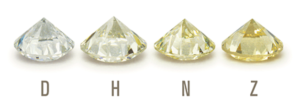
Colorless diamonds are more valuable.
Both radiant cuts and Asschers have a tendency to show color but for different reasons.
Radiant cuts show color because of their shallow corners and the way they hold significant weight below the pavilion. If you’re looking for a radiant diamond that’s colorless to the naked eye, don’t go below H on the color scale.
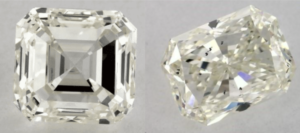
Asscher cuts show color because it’s a step-cut diamond. It isn’t designed to maximize brilliance, which can hide color. Asscher cuts with color grades above I are often colorless without magnification, but if you choose a larger diamond, it may require an H color.
Popularity
Industry estimates place radiant cuts as the eight most popular diamond cut and Asscher at number 11. Radiant cuts are two to three percent of the market.
Asscher cuts make up less than one percent.
Most diamond retailers have more radiant cuts in stock versus Asscher cuts. For example, Brilliance has 4,400 radiant cuts in their inventory. They have 2,000 Asscher cuts available.
The same is true of James Allen, who has 4,000 radiant cuts to choose from versus 1,800 Asscher cuts.
If you’re looking for the more popular cut with the most variety available, a radiant cut is right for you.
But Asscher and radiants provide the opportunity for an alternative to the traditional round cut. If you’re interested in a diamond that stands out from the most popular style, both cuts meet that standard.
Size
The size of a diamond is measured by its carat weight. If you compare two diamonds that each weigh one carat, they’re considered the same size.
Many buyers are concerned with which diamond looks the biggest, even if it’s the same weight as others. In this category, Asscher cuts are the winner versus radiant cuts.
One pro of Asscher cuts are a large table size. Straight facets make its surface area appear wider.
Radiant cuts hide much of their weight beneath the table, which gives it a smaller surface area. On the other hand, it’s elongated shape can counter this trait.
If you placed a two-carat Asscher cut next to a two-carat radiant cut, the former would likely look bigger.
Durability
The areas that most weaken the durability of a diamond are sharp corners and an extremely thin girdle. Inclusions in these areas make the problem more severe.
Sharp corners aren’t an issue for radiant or Asscher cuts. Instead, its corners are cropped to avoid sharp points.
Neither are likely to chip if hit against a hard surface or dropped.
If you’re looking for a cut that’s more durable than baguette, princess, or trilliant cuts, radiant and Asscher cuts meet the criteria.
A proactive step you can take to improve the durability of Asscher and radiant cuts is with a strong setting. Bezel settings feature a metal ring around the diamond’s crown.
The style diminishes the diamond’s brilliance but better protects it against impact.
Settings
The center diamond is the most prominent part of an engagement ring, but you shouldn’t ignore what the right setting can do for its overall appeal.
Both Asscher and radiant cuts fit a variety of settings, such as:
- Prongs
- Bezel
- Tension
- Cathedral
Many online jewelry stores allow you to explore how your diamond fits in a certain setting. Take the time to examine both radiant and Asscher cuts in many types of settings.
You might find the look of a radiant cut held in place by flat prongs or an Asscher cut with pave diamonds along the shank fits your style.
This Asscher cut is held by flat prongs.
If you want the focus on the center diamond itself, choose a solitaire setting where no other element of the piece draws attention away from it.
Keep in mind the setting’s color can impact the diamond’s appearance. You don’t want a setting that brings out yellow in an Asscher or radiant cut.
How to Decide Between Asscher and Radiant Cuts

Both cuts can serve as the focal point of engagement rings or line the shank supporting another cut. If you’re deciding between an Asscher versus radiant cut, here are some tips to help guide your decision.
You should choose an Asscher cut if:
- You aren’t concerned with maximizing brilliance
- A square-shaped diamond is appealing, but you don’t want it to have sharp corners
- You’re looking for a low price per carat compared to other cuts
A radiant cut may be right for you if:
- You want a brilliant cut that’s different from the traditional round and princess cuts
- Durability is important to you, but you still want a square or rectangular diamond
- You want a brilliant cut that costs less than others in its category
Pair both with multiple types of settings to find the design that’s right for you.
You can land on the perfect radiant or Asscher cut for your ring.

Jacob Clarke
Jacob Clarke is the founder of TeachJewelry.com.
He earned an Applied Jewelry Professional Diploma from the Gemological Institute of America (GIA) and now brings you essential information about diamonds, settings, and more.
Jacob has consulted with leading jewelry brands, and his work has been cited in Clean Origin, Diamond Nexus and industry publications.
He's also a member of the International Gem Society.
He enjoys discussing jewelry with readers, so contact him with any questions at jacob.clarke@teachjewelry.com.

